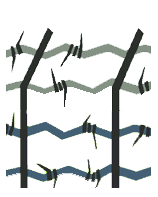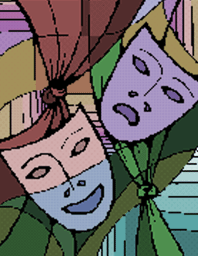|
|
«
…the Netherlands
certainly isn’t amongst the first countries that spring to mind when one
speaks about the Exile of German-speaking artists during the period
1933-1945. While one quickly connects names, groups and currents in this
context to cultural life in countries such as Switzerland, France
and the United Kingdom, Holland instead long has represented a terra
incognita.
...Exile of artists to the Netherlands
differed from that to other host countries; and this isn’t only because
- at first glance - cultural life there appears uninteresting. More than
in the case of other countries, the Netherlands were perceived of as a
transit station from where one attempted to reach the United States, or
at least Great Britain. Consequently, only rarely did immigrants try to
integrate there; they showed no interest for the traditions and culture,
thought it unnecessary to learn the language.
...In the field of culture, the
Netherlands was accustomed to foreign artists and groups presenting
their Art there, particularly in the area of musical theater since
the Dutch were very open to this type of import. Thus, the increase in
on-stage appearances during 1933 by German-speaking theater troupes
didn't seem unusual. A troupe was hired, performed, hopefully enjoyed
success, received reviews - and then moved on. It was that they
thereafter remained in Holland for which one was unprepared, lacking the
legal, organizational and social infrastructures to accommodate this.»
Dr Katja Zaich
“Ich bitte dringend um ein
Happyend.”: German Stage-Artists
in Dutch Exile
1933-1945
The Netherlands, due to its long-standing tradition of
freedom - as well as close historical ties and geographical proximity to
Germany - became a frequent refugee destination for many Jews. Indeed,
within six months of the Nazis seizing power, close to 15'000 German
refugees immigrated there... and by the high-point of this exodus in
1938 - following Germany's occupations of Czechoslovakia and Austria -
fully 30'000 refugees resided in Holland. For
some 8'000 of these, this host country would be the first stopping-point
in their search for a new homeland; however, for the remainder, finding
a means of existence in the Netherlands would prove extremely difficult.
As such, only about 4'500 found employment while the others had to live
with outside support. Initially, entry into
Holland didn't entail any formalities, as long as the refugee had a
valid passport.
However, March 1935 marked the end of the Netherland's
heretofore generous asylum policy. New requirements were implemented
which if not met could result in the refugee being turned away at the
border; and as of in 1938 anyone who wanted to enter Holland, even
temporarily, was required to possess a minimum of 300 gulden in personal
funds, while those who wanted to establish residence had to prove having
a personal fortune of at least 10'000 gulden.
Numerous solidarity committees stepped in to help. However, the full
significance of their intervention only would become apparent in 1940
with the German invasion of this totally unprepared and until then
neutral kingdom, as the overall Dutch population, to a certain degree,
went into "resistance mode". The most courageous
amongst them also acted to protect the refugees from the invading
oppressors. But Dutch spies working for the Nazis also were numerous, as
were the fanatical home-grown fascist groups that managed to attract
35'000 members into their fold. |
|
|
The Rudolf Nelson Revue 1935

Following their appearance in Switzerland, Nelson’s cabaret
group is engaged for an appearance at Louis David's Leidscheplein Theater in
Amsterdm.
That
the troupe already was well-known to the Amsterdam public is demonstrated by
the Het Volk newspaper article which appeared on April 27th 1934
about the troupe's up-coming arrival in Amsterdam the following day, and which even noted
the hour of the troupe’s train arrival so that fans could turn out in
number to greet them at Amsterdam Station.
The Revue, “1000 Takte
Nelson” premiers on May 1st 1934 with Rudolf Nelson and Fred Freed at
the grand piano… alongside Max Ehrlich, Kurt Lilien, Eva Busch, Dora
Paulsen, Fritzi Schadl and Walter Behr on-stage.
Walter Behr already
had appeared two months earlier at the cabaret Ping-Pong, Dora Paulsen
sings Damen der alte Schule (Ladies of the Old School) brillantly,
and Rudolf Nelsen is characterized as the ”Man of Hit Songs”.
Still, in its review
of the show, Het Volk also points out that perhaps one
or the other aspect of the revue presently is too “Berlin-centric… but
that this won’t persist, since anyone needs the time to get to know a
new audience”.
This appears to have
been the case; and in fact, Het Volk’s review of the following
show, “Etwas fuer Sie” (something for you) opening in end-May 1934,
observes that the troupe has found “insight into Dutch audience needs”,
possibly also reflecting the addition of Lotte Dewis, Harold Horsten,
Walter Fein and Peter Staub to the troupe.
June 15th 1934 marks the finish of this first guest appearance in
Holland by the Rudolf Nelson Revue. While Nelson scouts a new engagement
for the Revue, some of the troupe members individually make short-term
guest appearances in spa resort Scheveningen's Kurhaus-Cabaret.
Max Ehrlich and Walter Behr, together with Irmgard Andersen and Eva
Böhm, appear there in the Kurhais-Cabaret's July program. Subsequently,
the full Rudolf Nelson Ruvue is engaged to appear there for the
Summer Program.
At
summer's end, Max Ehrlich, homesick for his native land, decides not to
pursue his guest appearances with the Rudolf Nelson Revue.
Meanwhile
in Germany, Jewish entertainers once again may perform, even if only
within the framework of an organization called the KuBu… Juedische
Kulturbund (Jewish Cultural Union) and exclusively in front of
Jewish audiences.
Additionally, the KuBu’s leadership has reached out to Max Ehrlich in
Holland, asking him to return home and assume direction of their Light
Theater Department (kleinkunst Bühne).
Thus, in
late January 1935, Max Ehrlich sets out on his return trip to Berlin,
stopping over in Yugoslavia on the way for a stage appearance.
|
|
|
|
|

